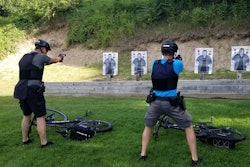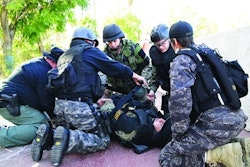Early last month, an officer with the Twinsburg (OH) Police Department successfully performed life-saving CPR on two different individuals in medical distress during a single duty shift.
According to WIOW-TV News, Officer Olivia Bartulovic was called early in her shift to a business that had reported a man on the premises to be unresponsive. Bartulovic performed CPR and awaited the arrival of EMS responders, who then transported the man to a nearby hospital where he was later reported to be in stable condition.
A few hours later, Bartulovic was the first to the scene of another unresponsive man, and she again performed CPR in advance of the arrival of EMS. That individual was alert and talking with responders during his ambulance ride to the hospital.
Bartulovic told the local news station, "It was sort of after my shift I realized, 'Wow, I did CPR on two people in one day, I've never done that before'."
Officers provide life-saving medical assistance—everything from Basic First Aid to CPR and more complex care such as tracheotomy and severe hemorrhage—every day in America. These incidents often go unknown and unnoticed by everyone but the people immediately impacted by the event.
However, when an officer's actions are as noteworthy as Bartulovic's in Ohio, we are reminded of how important it is for police to regularly train in life-saving skills.
More than the Minimum
For years, the standard requirement for police officers across the country for first aid training was the basic course provided by the American Red Cross. In fact, in some places that's still the only requirement—a problem that requires further attention (and funding appropriation) by administrators and trainers before it is fully resolved.
However, agencies nowadays—for the most part, anyway—provide officers with much more than this minimum of training and equipment.
For example, there is a greater focus on hemorrhage control because agencies now recognize how important it is to staunch any heavy bleeding the first few moments after a traumatic injury—this was highlighted just a few weeks ago in this space.
Many officers are now outfitted with (and trained on the use of) Individual First Aid Kits (IFAKs) containing a tourniquet, packing gauze, pressure dressings, bandages, rescue shears, hypothermia wrap ("space" blanket), hemostatic agent (QuickClot), and some simple wound cleaning agents such as saline or an over-the-counter antimicrobial.
Officers should be given ample time to familiarize themselves with how to use each of these pieces of equipment. There are a number of training tools available with which officers can practice. CPR manikin kits (adult and child size) are practically a must. Most academies have "blue trainer" tourniquets—many individual officers even have their own.
Train, Train, Train!
Providing emergency first aid such as CPR, applying a tourniquet, stopping a sucking chest wound, or staunching the bleed of a gunshot wound is difficult and requires hours of training and preparation.
Doing things like Officer Bartulovic did in Twinsburg last month may sound easy enough—and those moments may have come as something almost second-nature to her—but training for such an eventuality is the only way to be truly prepared.
Applying a tourniquet when ones hands are covered in blood, or stopping the bleed of a gunshot wound when the blood is flowing from your own body, or performing CPR when you yourself are out of breath from having run into and out of a burning building or raging floodwater, is an entirely different enterprise than practice in a sterile environment.
Train. Train. Train.
















